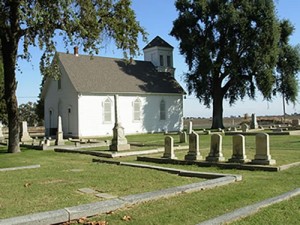
by Denise Minor
South of the town of Knight’s Landing off Road 113 sits Mary’s Chapel and Cemetery. The white church is stoic and plain with a narrow steeple that punctures the sky. The graveyard behind it has thick grass and ancient tombstones clustered by families.
Names on the stones are decidedly German and English. The Longs, Kennedys and Glascocks all boast “Native of England.” Interspersed among them are families with names such as Shneegas, Zimmerman and Clausen. Some read “Native of Germany” and others “Native of Bavaria.” In a clearly demarcated plot rests Henry Clausen 1826-1901 on one side and Catherine Clausen 1840-1922 on the other. Between them are the gravestones for Charlie 1870-1888, Julia 1869-1871, and Minnie 1875-1895. Did this man and woman suffer three times what many of us would consider the worst experience possible — the death of a child? Were there other offspring who survived?
Mary’s Cemetery does not tell. But it does tell of a long stretch of time during the 1800s when Germans and Brits farmed this land. I look at the road and imagine people there in dusty calico and denim talking in German about the crops and the rain. I picture the bilingual community gatherings in this area (maybe even at this church) where teenagers of two different cultures flirted with one another in German and English. I think of how unchanged this place is in many ways. Still, families are farming here. Still, there are two cultures and two languages, although now they are the American English and Mexican Spanish of this century. And still, at a crossroads in the Northern Sacramento Valley, where probably only one car passes per hour, there is this beautiful quiet place with stones to remember the names of the dead.
Denise Minor is an assistant professor of Spanish linguistics at Chico State and adviser to chicoSol in Spanish.
